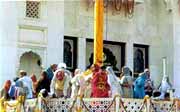|
The Pyre is prepared at the cremation ground. The corpse is placed
on it and ghee is poured in the mouth, eyes and nose. The left-over, dough-balls
are given in offering, after which the eldest son sets fire to it, starting
at the head and then going round clock-wise.
 Some Hindus perform havan before igniting the pyre. Sikhs recite hymns
from the Holy Book, read Sohila, and offer prayers for the peace of the
departed soul. When the body is almost burnt, the ritual Kapal Kirya (breaking
the skull) is performed. The chief mourner, generally the eldest son,
breaks the skull with a hard pole, the idea behind the ritual being that
the skull burns up completely.
Some Hindus perform havan before igniting the pyre. Sikhs recite hymns
from the Holy Book, read Sohila, and offer prayers for the peace of the
departed soul. When the body is almost burnt, the ritual Kapal Kirya (breaking
the skull) is performed. The chief mourner, generally the eldest son,
breaks the skull with a hard pole, the idea behind the ritual being that
the skull burns up completely.
On their way back, mourners bathe at a pond or well,
wash all their clothes and perform another ritual in which each
one sits on the ground, bends forward, takes a blade of grass in his hands
and after the priest has chanted a verse, breaks it into two and throws
it back behind his head, thus severing all worldly relations with the
dead man. Sikhs generally go to Gurudwara before going home and offer
prayers for the benefit of the departed soul and distribute the traditional
pudding, Karah Parshad. After this the funeral party disperses. In earlier
times, the mourners invariably stayed on near the pyre till sunset. Small
children are generally buried and not cremated, but the Sikhs cremate
their children also.
Till decades ago, if a person died of small-pox or of
an epidemic, his body was immersed in water and not cremated. It was believed
that epidemics were caused by the anger of some gods or goddesses and
a person who caught any of those diseases was actually possessed of those
gods and goddesses. Burning such a body would mean torturing the god or
goddess along with it, which would further offend the already angered
deity.
On the fourth day after the death, but not on a Wednesday, the rite of
Phul Chunana (picking the charred bones) is performed. In the evening
the Chautha ceremony is performed, a condolence meeting at which all the
relatives and friends assemble. If the Chautha falls on a Wednesday, it
is performed a day earlier. While picking the bones, diluted milk is put
in one vessel and all bones which are picked up are washed in it and then
put either into a bag or an earthen vessel. The ashes are also collected
and immersed in a stream, if there is one nearby. But the bones are taken
to Hardwar and immersed in the Ganga. Some Sikhs take these bones to Kiratpur
and immerse them in the river Beas. Kirya, the chief ceremony after death,
is performed on different days by different clans. Some perform it on
the 10th or 11th day, some on the 13th, and some on the 16th day after
death. In rare cases, it is even performed on the 21st day. The Jats of
the Punjab perform it on the 10th day and call it Dasahi. Brahmins perform
it on the 11th day. Other Hindus perform it on the 13th day and call it
Tehravan. On this day all relatives and friends assemble in the afternoon
in condolence. Some Hindus perform Havan on this day. Sikhs have a non-stop
reading of the Adi Granth, Kirtan and prayers. The eldest son of the deceased
is ceremonially installed as the head of the household in place of his
father and as a token he wears the turban usually given for this occasion
by his father-in-law. If the wife of the deceased is alive, the Nain comes
and ties her hair after which all relatives according to the nearness
of their relationship give her some money. This is called Sarvanna. This
is a sort of financial aid to the widow. When a woman dies, her parents
bring the turban which her husband wears on this day. If however, he intends
to remarry, he does not wear this turban.
All friends and relatives are served food on this day.
If a man dies of old age, his death is celebrated and halwa and puri are
served to all mourners assembled. Utensils, clothes, beddings and fruits
are given in charity in the name of the deceased. After one year the death
anniversary is performed, this is known as Varina. Hindus feed Brahmins
on this day. Sikhs have a non-stop reading of the Adi-Granth, Kirtan and
arrange to serve food to the Panj Piyaras. |

